All About Dental Diastema (Space Between The Teeth)
Dental diastema is a space between teeth. There are many causes of diastema, a condition that affects both the jaws and teeth.
The most common cause is the tooth being too small for the jaw. Loss of anterior teeth or gum surgery can also cause teeth to break and lead to diastema.
Apart from these reasons, it is not surprising that in today’s digital age, where social media is an integral part of our daily lives and is often held responsible for depicting an ‘ideal’ body image, people question their appearance and lose their confidence.
Unfortunately, negative body image is becoming more common and starting at a very young age, leading to low self-esteem, anxiety, and depression.
Many different factors affect how people feel about themselves, including the appearance of their teeth.
Teeth are one of the first things to be noticed in a person, and they are also the most memorable.
Interdental spaces are aesthetically uncomfortable and people may encounter some difficulties when speaking.
Sound can be heard from these spaces, as well as the possibility of damage to the tongue by entering between the teeth.
Continuous tongue gap causes teeth to open over time and discomfort begins in terms of appearance. As a result, a defective mouth, which includes misaligned teeth, discoloration, missing teeth, and spaces between teeth, negatively affects a person’s mood and emotional state.
Missing teeth and imperfection of the mouth due to the spaces between the teeth negatively affect the mood and emotional state of the person.
What Is Dental Diastema Symptoms
The only symptom of diastema is a visible gap between the teeth.
What Is Dental Diastema Treatment
Diastema is usually treated with braces, but the important factor in determining the treatment to be used is the distance between teeth.
Apart from the braces, 4 different treatment methods are widely applied considering the threading distance.
-
Composite Veneer
This is a simple method that is frequently used in mild cases where the distance between the teeth is close to the minimum and also in mild anterior tooth fractures.
The composite material, which is in paste form, is used by the specialist dentist to cover the teeth that make up the gap and close it.
It is a practical method and is often resolved in a single session. It is slightly more sensitive compared to other methods, teeth repaired with composite veneers should be protected. After the veneer is applied, patients should be very careful about dental care.
Especially for a few days after the application, tea and coffee consumption should be reduced.
-
Porcelain Lamina
This is a method used in the healing of mild to medium tooth gaps and moderate tooth fractures. In this method, the tooth is not completely cut and only rasped in the appropriate amount.
Then the laminates to be bonded are molded and made to fit the tooth. In the last stage, the prepared laminates are attached to the tooth with strong chemical adhesives.
Although it takes 2-3 times longer than the Composite Veneer method, it offers a more robust solution. It is the method in which healthy tooth tissue is lost least.
-
Orthodontic Treatment and Complete Denture
They are suitable methods to apply when there are advanced tooth gaps and bite disorders. Depending on the cause of the disorder, surgeries involving the jaw and the general mouth structure can be applied.
In openings that are very difficult to treat with other methods, or in cases that cause the loss of a large part of the teeth, it can be presented as a solution for a complete dental prosthesis diastema.
It is much more tiring than the other two methods, but it is a permanent solution.
-
Lip fillers
In addition to dental treatments; disorders can be treated with plastic treatment or lip fillers and botox applications made by dermatologists.
Treatment Process

The dental diastema treatment process
According to the clinical and radiological examination, the gaps are analyzed first.
The analysis made will show which teeth will be included in the treatment, as well as inform how much the size of the teeth to be included in the treatment will be expanded.
This analysis can be performed on the model obtained from the patient or in the patient’s mouth.
After the size analysis is done, the adhesive restorative material in the color suitable for the teeth is selected and the demo prepared with the obtained models is applied to the patient’s mouth.
In this way, the patient is informed about the possible outcome of the treatment. At this stage, within the limitations, the length and width of the teeth are adjusted to optimize the result.
After the operations on the demo are completed, the appropriate colored adhesive restorative material is applied with the teeth to close the gap and the treatment is completed after the polishing stages.
See Also:
Types Of Dental Braces to Choose From

As a nutritionist, I research, find and experiment with recipes, natural diets and meal plans for weight loss, bodybuilding, and detoxing.
